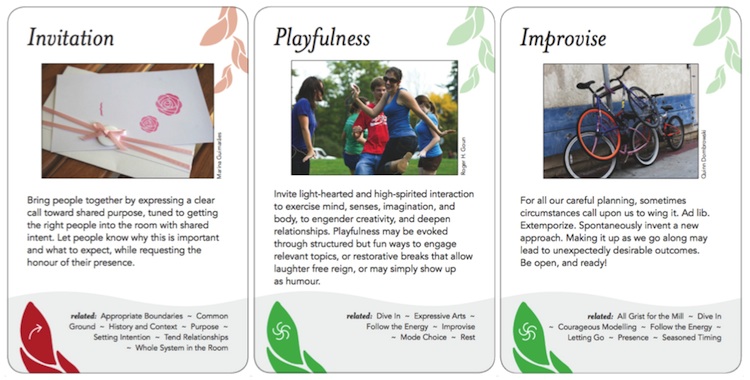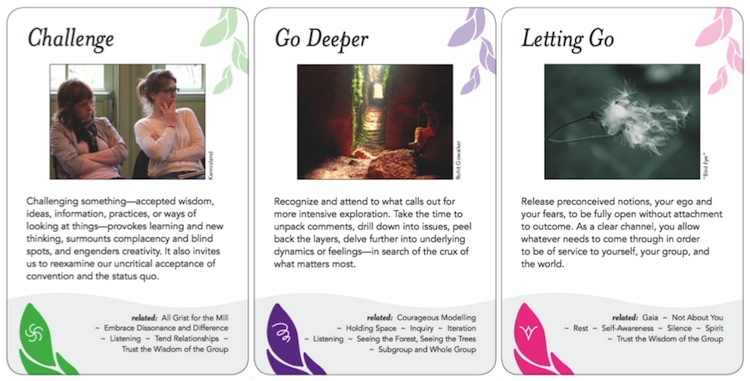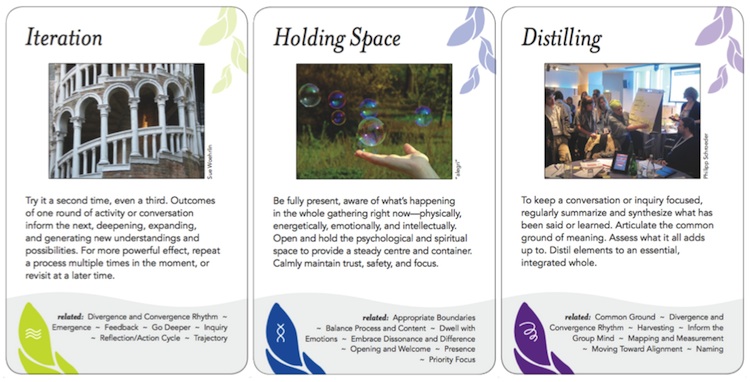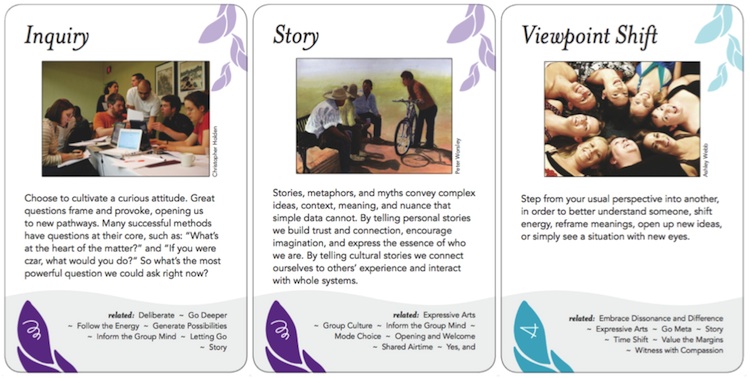
painting “In Deep Conversation” by Irish artist Pam O’Connell
When I was younger, most of my waking life was consumed in conversations. In my work life, I learned that most learning occurs, and most decisions are made, in small group conversations, often ad hoc. I was persuaded that good conversation skills were the key to good relationships. I believed, in short, that conversation mattered.
Now that I’m no longer working, and rarely required to converse with anyone, I’ve come to believe that, as GB Shaw put it, “the biggest problem with communication is the illusion that it has taken place”. In retrospect, I would guess that most of the conversations I was party to over the years were incompetently conducted and largely a waste of time. The conversants, for the most part, had already decided what they believed or what needed to be done, and were just looking for reassurance. Or they were talking to hear themselves think, and not listening to anyone else. There was almost never any real exchange of information, or ideas, or perspectives, despite the earnest attempts of the conversants to convey these things. Our languages are not very good at that, and the complicity of creatures that make up what we believe to be “us”, as individuals, rarely allows our minds — their minds really — to focus more than a small bit of our attention on anything not directly relevant to the needs of the moment. And our culture does its best to obfuscate and distort the meaning of words and the events of the day, so that most of what we manage to convey is probably lies anyway.
So lately I have chosen to converse less, even in the company of others. I begin conversations less often, say less, and become restless with what others are trying to say more quickly. I have become a more sensuous, perceptual and intuitive person and less conceptual and verbal. I would rather just be with the people I love than talk with them.
When I meet someone new who intrigues me, someone (male or female) I might like to spend time with in some shared activity other than talking — or perhaps doing nothing more than just being with them in some beautiful place — I now try to begin, like a feral creature, with non-verbal communication. Nature has equipped us, since the aeons before our newly-invented languages, with a very powerful set of tools to communicate without words. Body language, eye and facial movements, pheromones, a host of (to us) subtle means of conveying what we feel without saying a word. There are a million ways to smile at someone, to smile with someone, and our bodies are very adept at translating their meaning, as long as our heads don’t get in the way. Few joys can compare, for example, with flirting wordlessly with someone and knowing you have made a connection. Alas, in our desperate, lonely modern world flirting is too often seen as intentional, a lead-in to something serious, rather than just play, pleasure, joy, something done for its own sake.
Eventually, however, it is likely that I am going to have to engage the people whose company I like, or think I might like, in conversation. Our first conversation with someone is almost always precedent-setting: if it’s small-talk, or appreciative, or attentive, or inviting, the other person will probably come to expect more of the same from us. So the one who opens the conversation is now more or less obliged, committed, to provide more of the same, and if that opening was banal, or inauthentic, or hyperbolic, or aggressive, it does not bode well for the future of that relationship to be equal, honest and interesting.
In recent years, as someone with relatively high self-esteem and with nothing to lose for trying, I’ve tended to open conversations with an invitation. That’s true whether my tentative interest in them is intellectual, romantic, collaborative, or aesthetic. Being forward carries the risk of a direct ‘no’ reply to your invitation (or worse, an apologetic, ambiguous reply intended to be a ‘no’). But my sense is that we’re pretty quick deciders, we humans, and that by the time I utter the invitation the recipient’s answer is already decided, so preceding it with a bunch of polite and/or flattering blather is unlikely to change anything, and might create false understandings or expectations.
Lately I’ve wondered whether there might be a better way to start a meaningful conversation with someone. That has got me asking: What are the “conversations that matter”, if most of the conversations that consume our lives do not?
I’ve recently returned from a series of events at which I’ve been extolling the use of the Group Works deck, a set of 91 cards representing the characteristics, or “patterns” of exceptionally effective “group processes” — meetings, conferences, collaborative and deliberative events — that an event facilitator or participant can invoke or draw upon. It’s occurred to me that the same qualities that make for a great meeting — qualities like a great location, inquiry, advance research and preparation, playfulness, letting go, listening, openness, improvisation etc. — could also be the qualities of a great conversation. But, again, bringing these qualities to the conversation is, likewise, only worth pursuing if the conversation is one that matters.
To try to answer this question — what are the “conversations that matter”? — I’ve been reviewing and reflecting upon the conversations in my own life that have made the greatest difference — those that brought about a major, sustained change in what is done, what is believed, or what is understood by one or more participants in the conversation.
My analysis of these conversations suggests that “conversations that matter” tend to be one (or more) of five types, each of which has an essential question that the conversation generally turns on (the cards pictured above each type are from the Group Works deck — more about them later in the article):
1. Existential (Connecting) Conversations / What Do You Really Care About, and Why?: Not who do you care about, what do you care about deeply, with all your heart, to the point it drives you, makes you crazy, makes you leap tall buildings, commands your attention, affects your behaviour, profoundly informs your worldview, makes you ache so much that sometimes you cannot bear to think about it, or witness it? And why do you care so much?
It takes courage to have a conversation about such things, since we often can’t control our feelings about them, and that lack of control makes us vulnerable, defensive, self-protective. But what could be more important to talk about? These are the things that define us, and an understanding of them can clue us in to who we really are. To ask “what do you care about?” is to ask “who are you?”.
Ask me what I care about most and I’d say, I think, it’s the needless suffering of all the creatures of this world (including humans), and the needless and disastrous desolation of our planet. I know I can’t change it, I know no one can stop it and that it will get worse until our civilization collapses, and that no one is to blame. But knowing this doesn’t make me care any less about it. We can’t control or change what we care about. I care about this because I can see, sense, intuitively know that when we lived in the rainforest, for the first million years of our species’ existence, we had everything we needed for an easy, joyful, sustainable life and so did the rest of all life on Earth. I’m filled with grief that we lived an idyllic, harmonious life, and for whatever reason (the reason no longer matters) we abandoned it, destroyed it. Now we are facing the terrible consequences.
I care, too, about beauty and love and wild places and play and peacefulness. I can’t get enough of these things. I pursue them, always and everywhere. I have always cared about these things and they have driven me all my life, made me who I am, who I always have been. I care about them because when they’re present — when I’m present — time stops, and the grey disconnecting veil through which I see the whole world from inside my head lifts. I become another person, free, my true self, connected with and at one with and part of all life on Earth. Real.
2. Intentional (Challenging) Conversations / What Do You Most Want (to happen or to achieve in your life), and Why? If it’s unlikely to happen (the big lottery win) or likely impossible to achieve (the perfect happily-ever-after relationship/life), what is it that keeps you dreaming about it, what is the cost of your obsession with it (lack of presence, wasted life, lifelong dissatisfaction), and what would it take to let it go? And if it is realizable or achievable, why is it so important to you, and how might you free up your time and energy from the urgent needs of the moment to begin to begin to achieve it?
While we can’t control or change what we care about, we may be able to change what we want. We may be able to stop hopelessly wanting what we can probably never have (despite the media’s relentless want-creation and perfection-is-possible-and-desirable machine). And despite Pollard’s Law of Human Behaviour (the “merely important” things always get back-burnered in favour of what’s urgent, and then, in our exhaustion, in favour of what’s easy and/or fun), we do have the capacity to simplify our lives, reduce the number of urgent tasks we face each day, and the amount of stuff we have that we have to look after, so we can get around, at last, to realizing or achieving what we really want. Or, if that’s impossible, stop wanting it and move on with our lives.
Ask me what I want and one of my responses would likely be “a life without stress” (since I handle stress badly, physically and emotionally). It’s a foolish, impossible desire, even in my relatively idyllic retirement, and I would be wise to let it go, and instead pursue practices that increase my resilience to stress. Another response would likely be, perhaps ironically, I want to know what I really want. Since collapsing into retirement I have taken up a lot of hobbies, taken on a lot of projects, and done some very satisfying work. But I’m still not happy that I’m fulfilling my purpose in this world, and a lot of the things I think I should do, or should want to do, I somehow know I don’t want to do (though I’m not sure why). Get me in a conversation about this and I’ll have your head spinning. But for me, at least, it would be a conversation that mattered.
3. Learning (Exploring, Capacity Building) Conversations / What Information, Ideas, Understandings, Insights and Perspectives Can You (We) Offer (Share)? Learning is an iterative process. True exchange of knowledge and meaning occurs interactively and contextually. “What do you mean by that? Are you saying… If that’s true then… But what about…” — this back-and-forth struggle for coherence and appreciation is how true communication occurs. As TS Eliot put it, “Trying to learn to use words… every attempt is a wholly new start, and a different kind of failure, because one has only learnt to get the better of words for the thing one no longer has to say, or the way in which one is no longer disposed to say it. And so each venture is a new beginning, a raid on the inarticulate with shabby equipment always deteriorating in the general mess of imprecision of feeling.” Many of us blog principally because it enables us to have learning conversations with ourselves (with a little help from our readers). For many, reading is a learning conversation with the writer. And the best learning conversations are not debates or competitions for nods of agreement, but offers — of information, ideas, understandings, insights and perspectives. The point of the offer is not to get attention or appreciation, but to help.
Conversations, if the space for learning is held open by the participants, enables learning through exploration in a way other forms of learning cannot. Exploration (“What if…”) gives participants permission to stray from the script of the text, and it is in this way that unexpected connections and discoveries are made, and powerful collective learning results. And conversations can be interspersed with demonstration: “Let me show you… Now you try it… Why do you do it that way; what if instead… I don’t understand… Try this… — improving the capacities of both teachers and students, while often blurring the line between them.
These days, as I’ve written often on these pages, my beliefs and insights on the things I think important are so radically different from, and unsettling to, most people’s thinking that I have few opportunities for totally candid conversations about them. So my learning conversations with others are often of the “just help them get started” variety. By suggesting readings, providing factual information, telling stories, I can subversively impart radically different perspectives and understandings by allowing other conversants to draw their own conclusions. The games that I’m working to develop now, on the Gift Economy, and on Preparing for Collapse, are really just a framework for Learning Conversations about these subjects.
The conversations from which I learn the most are those that include masterful conversationalists, people who can (seemingly) effortlessly and unobtrusively steward and shepherd the conversation to make it more relevant, succinct, focused, articulate, and effective at its purpose. More about that later in this article.

4. Inviting (Engaging, Playing, Creating) Conversations / What Do You Like to Do? What Are You Really Good At? We all love to play, and conversations that invite others to play, that engage them and encourage them to do what they enjoy, things that stimulate their creativity, imagination and sense of humour, open us and them to the unpredictable products of any joyful activity that draws on our energies and passion. Invention and innovation. Enduring, creative partnerships. Works of art. Love.
Invitation is itself an art form, and the best Inviting Conversations are usually preceded by thorough research and carefully crafted. If the invitation is misrepresented or inauthentic, it will be a quick conversation-stopper. Paradoxically, we spend so much of our lives doing things we think we must do, that we are often unaware of the things we like doing, and the things that we’re good at doing, and Inviting Conversations can enable their discovery. These are often conversations where the non-verbal “conversation” is at least as important as what is actually said. Such conversations often benefit from the use of tools that allow visual expression of what is said or meant, to complement the verbal record.
In recent years, as I start to take my importance, and myself, less seriously, this has become my favourite type of conversation. Clever banter is not small-talk, it is a form of play that takes practice to become skilled at. My way of making new friends is to explore with people what they like and what they’re good at, and if these are things I also enjoy, figure out what we might both like, or what we might together offer the world, and use that as the invitation to both an activity and a relationship.
5. Problem-Solving (Collaborating) Conversations / How Might We Deal With or Respond to (a specific issue, challenge or predicament)? Of the five types, this is probably the most difficult type of conversation to facilitate and enable. This is because few people understand that most modern ‘problems’ are actually complex predicaments, and that simplistic solutions (despite what politicians, consultants, business ‘leaders’ and others try to tell us) rarely ‘fix’ them, at least not for long. In such cases it is usually more effective to look for ways to adapt to the predicament, approaches to deal with it, and mitigate its worst effects.
We all love a challenge, and conversations that have a purpose as pointed and explicit as solving a specific problem are often enticing. What is more difficult is facilitating such conversations in such a way that the tendency to oversimplify, create false dichotomies and choices, and rush to conclusions (who will do what by when) is reined in, and the true nature of the problem (and why it has resisted previous efforts to ‘solve’ it) have become clearer. Understanding the true nature of a complex problem (predicament) and discovery of possible approaches to deal with it generally co-emerge from thoughtful, open, genuine inquiry through conversation. Getting all the voices in the conversation heard, ensuring the relevant information is at hand, getting participants to see things from different perspectives, and encouraging stories that help clarify and level knowledge and bring appreciation of the issues complexity, require patience from the group and self-discipline from participants.
These days I don’t engage in many Problem-Solving Conversations. Because they consumed so much of my work life, when I retired from paid work I also resolved to retire from such conversations. Much of the work of the Transition movement is conversations of this type, however, so my focus now is learning (slowly) how to be better at facilitating them to avoid the landmines so many of my work-life conversations encountered.
• • • • •
So how do we engage in such “conversations that matter”? Baldly asking the essential questions corresponding to each of the five types of conversations above, especially of someone you don’t know well, might well produce a defensive or even angry response. One possible way to broach an Existential, Intentional, or Inviting conversation might be to ask (especially of people with busy schedules): If you had one extra hour each day, what would you spend it doing? Their answer to this question might hint at what they really care about, want, or like, and precipitate a conversation on that subject.
What is most needed to make Conversations that Matter more effective, I think, is better facilitation of such conversations. That’s where the Group Works deck I mentioned earlier comes in. Although it was designed (by a group of 50 people, of which I was one) to help meeting and other “group process” facilitators design and conduct such activities more effectively, I’ve realized that Conversations That Matter are really just a form of “group process”, and while most such conversations are ad hoc and do not have appointed facilitators, there is no reason why all the participants of such conversations shouldn’t hone their facilitation skills and gently apply them in such conversations (in an unofficial role often called “guerrilla facilitation”) — at every stage, from pre-conversation ‘design’ (research, location-setting etc.), intention- and context-setting, tending the relationships and flow of the conversation, encouraging creativity, inquiry and synthesis, perspective shifts and trust, and modelling exemplary conversational skills and behaviours that others can learn from and emulate. The 15 card images depicted above show some of the 91 patterns of exemplary practice that might be applied to different types of conversations.
So the next time you find yourself in, or scheduled for, a conversation, ask yourself: Is it a Conversation That Matters? If it isn’t, see whether with some tweaking it might be made into one (or else consider whether you want to avoid it). And if most of the conversations you engage in are not Conversations That Matter, maybe it’s time to shift gears and find ways, and people, to initiate and participate in ones that are.
And when you do, pay attention to what’s happening in the conversation beyond just the words said. Chances are you’ll discover there are some masterful conversationalists in your circles (I’m not one of them, by the way, not by a long shot). Study them, learn from them, discover how they “guerrilla facilitate” the conversation, and follow their example. It’s one of the most important skills you can learn.









Dave, I love your ideas and your writing so perhaps I can be forgiven for quibbling with some things. You write:
“…I can see, sense, intuitively know that when we lived in the rainforest, for the first million years of our species’ existence, we had everything we needed for an easy, joyful, sustainable life and so did the rest of all life on Earth. I’m filled with grief that we lived an idyllic, harmonious life, and for whatever reason (the reason no longer matters) we abandoned it, destroyed it.”
How do you know this? It seems more like a romantic fantasy to me. Hobbes’ “war of all against all” is just as true (perhaps more valid overall) a description of nature as yours.
Otherwise, a great essay. Thanks.
PR
Pingback: Conversations That Matter « how to save the world | Science and Sanity | Scoop.it
Pingback: Conversations That Matter « Poor Richard's Almanack 2.0
I wish you were part of our tribe : you bring such quality ideas that make everybody richer…
We would be in a high exchange ratio.
thank you
Dave, I can’t resist posting this Scientific American article bearing on the romantic idyls of Mother Nature: 13 Horrifying Ways To Die (Arthropod Edition) http://blogs.scientificamerican.com/compound-eye/2012/10/31/13-horrifying-ways-to-die-arthropod-edition/
Pingback: Conversations That Matter « how to save the world | Positive futures | Scoop.it
Pingback: Conversations That Matter « how to save the world | Mindful Leadership | Scoop.it
Pingback: Conversations That Matter « how to save the world | Self Memory Nostalgia | Scoop.it
You have effectively summarised Theodore Zeldin’s (Oxford University) extraordinary work on conversation. And I do believe you are right.
Pingback: Conversations That Matter « how to save the world | KnowledgEvolution